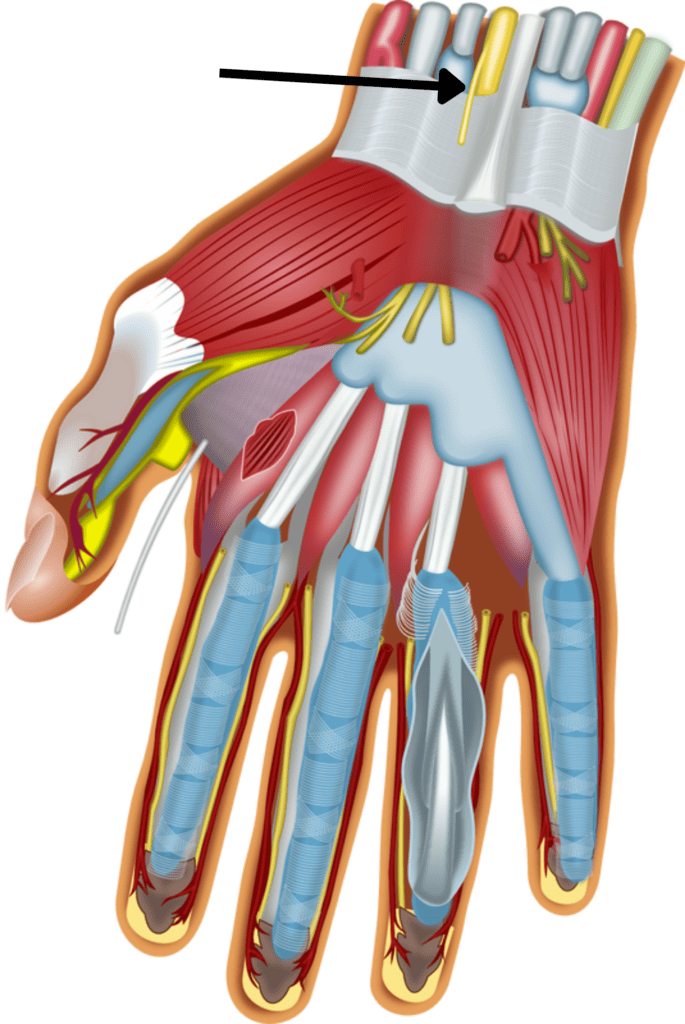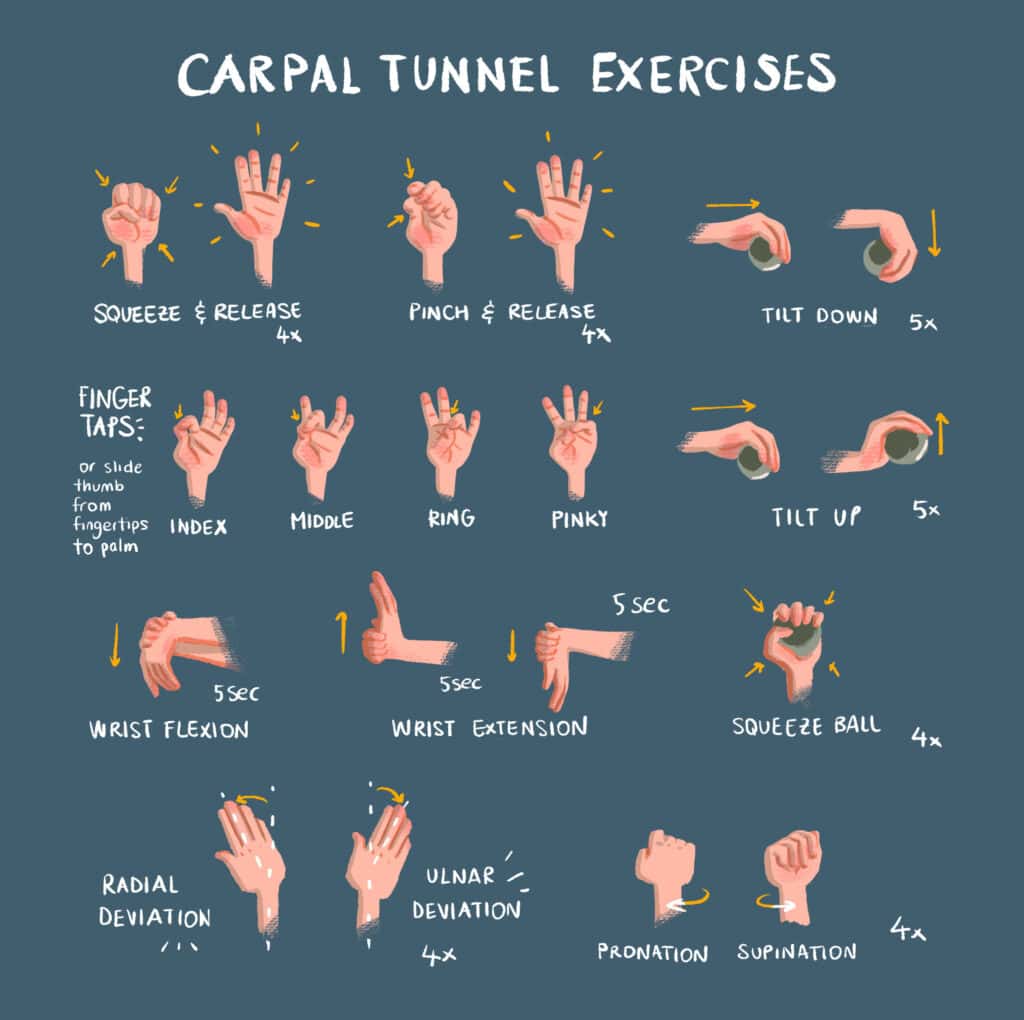If you spend the majority of your day typing while sitting down at a computer, this article is for you. We’ll discuss recognizing symptoms of carpal tunnel syndrome and how to prevent/treat it.

Carpal Tunnel syndrome (CTS) is a painful condition that is very preventable and I’m here to raise awareness as it’s something I’ve experienced personally. Initial symptoms of CTS include numbness and tingling in the thumb, index, and middle fingers as well as generalized wrist pain. Put simply, we have a large nerve called the median nerve (see picture below) that passes through our wrist, sandwiched between our wrist bones and a ligament. When we perform repetitive motions of the wrist, such as typing, this nerve gets entrapped and inflamed within the tunnel.
There are a plethora of other factors that may cause this syndrome including: texting, driving, reading, sleeping in weird/non-neutral wrist positions, painting, riding motorcycles, and many others. For me personally, I acquired CTS from a combination of typing on a laptop keyboard (non-ergonomic) every day for work and over-doing hot yoga poses that put a lot of pressure on my wrists.

Note: CTS can progress into severe wrist pain worse at night, radiate pain up the arms, and reduce grip strength with hand weakness. CTS often presents with symptoms on just one side but also can be bilateral. please make an appointment with your doctor so they can evaluate for other possible sources of pain, especially if your symptoms are severe. Sometimes symptoms of osteoarthritis, cervical radiculopathy, rheumatoid arthritis, amongst others can mimic carpal tunnel syndrome so keep this in mind!
- The first step is to figure out the source of your symptoms! Start paying attention to the movements that aggravate your symptoms and identify what activities in your daily life may be causing your carpal tunnel pain.
2. Adjust adjust adjust! Once you identify the source of your symptoms, find a way to work around it to prevent further aggravation. If you type a lot for work, find a dictation software or purchase an ergonomic keyboard. If you do yoga, try to take a break or do ground poses on your forearms to take some pressure off of the wrists. Lastly, try not to text as much using your thumbs~ I know you’re probably laughing at me thinking this is impossible but don’t knock it till you try it. Try putting your phone down on a surface and texting using your pointer fingers (yes like your parents do). Also you can try Siri dictation or just sending audio messages more often to save your thumbs and wrists from the pain!
3. Treatment! Reminder that I am speaking from my own experience and what I recommend to my patients IN GENERAL for carpal tunnel syndrome. Please keep in mind each case is different and what may work for someone else may not work for you. The first treatment I recommend is purchasing wrist braces to start wearing every night AND keep on throughout the night. I know this is cumbersome but this is the first-line treatment! By ensuring the wrists are protected, i.e. neutral, throughout slumber, the carpal tunnel can decompress. It can take several weeks to a few months for pain to completely resolve, so be patient. I do not recommend wearing the wrist braces during the day as this can cause stiffness and worsen hand stress due to the level of hand restriction while wearing the braces.
4. Stretching– of course this is part of treatment but it’s also crucial for prevention of any future episodes. If you work a job that involves lots of typing, I recommend taking breaks every 30 minutes to stretch out, especially your wrists. Also, making sure you have a 90 degree angle between your arm and forearm while sitting at a desk ~ergonomics~. Right below are some amazing stretches that I personally used when I was experiencing carpal tunnel syndrome and helped relieve my pain significantly. Don’t overdo it with the stretching either, but go through this whole sequence a few times a day, holding the stretches for no more than 30 seconds at a time.

5. Other treatment options: If stretching at home is not for you, I’d recommend asking your primary care to refer you to physical therapy. That way someone else can help keep you accountable for regular stretching and exercises to help with CTS pain. Additionally, there is always the option to get a steroid injection directly into the carpal tunnel. I will be very frank here, I do not recommend getting a steroid injection unless you have exhausted your other treatment options. I was desperate to get relief immediately due to how painful and severe my wrist pain was and it was one of the most painful experiences of my life. Although it is a quicker fix, a steroid injection is an invasive procedure that may have unintended consequences and may require repeat treatments. Many don’t know that repeated steroid injections can damage the joint and cartilage over time. If all other treatments fail, there is the option of carpal tunnel surgery where the ligament overlaying the median nerve is cut. Again, past initial splinting and stretching, talk to your primary care provider and figure out what treatment modality will be best for you and your lifestyle/needs.
Just a few months ago, I would cry every day en route to work because gripping the steering wheel was so painful. If you are suffering from carpal tunnel syndrome, I know how frustrating it is to have pain in your hands. Unfortunately, we use our hands for nearly everything. A simple task with your hands becomes tedious due to discomfort, numbness, or those awful pins and needles sensation. Please take care of yourself throughout this time and from the bottom of my heart, I hope you feel better soon.
Yours truly,
-Your Pocket PA, Foya Tavangary PA-C

